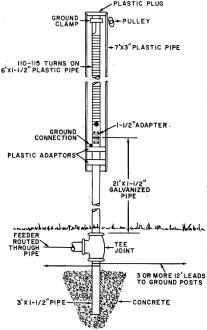Flag-Pole Ham Antenna
|
|
Camouflaging amateur radio antennas and their mounts is not a new concept, although an increasingly large amount of prohibitions by community organizations and/or municipalities have made the lives of many hobbyists more difficult. The ARRL's QST magazine issues are replete with articles describing how desperate and determined Hams have managed to erect successful antennas in spite of imposed limitations. Flag poles have long been the means of disguising vertical antennas of the 1/4-wave, 1/2-wave, J-pole, and other formats that are constructed in a long, straight line. Some authors are just-the-facts types and aptly present all the required information for getting the job done. Others, like Roland McMahan, throw in a bit of humor to help take the bite out having such an otherwise unnecessary task imposed upon him - in this case at the "request" (pronounced "insistence") of his YL. Flag-Pole Ham Antenna Vertical helix disguised as a flag pole produces good results When we moved to our new house, my usually gentle and permissive wife issued an unusual ultimatum: "Please do not put up a spider web of antennas around our new home." For a moment, my world reeled; 40 years of spider webs - uh, amateur radio - had taught me that a good antenna is the first requirement of a good station. I ruminated for a while, rejecting the idea of an antenna camouflaged to look like a lightning rod in a location where lightning rods are a rarity. A flag pole? We're patriotic enough to have had one at our last location, so I was sure my wife wouldn't object. Now, I became obsessed with the idea of designing a flagpole antenna. Trial and Error The various handbooks cover vertical antennas very well - except for the helix, which is probably the easiest to build, consisting of a half-wave length of wire wound on a form. Convinced that this was the design I needed, I wound 70 ft. of #12 insulated stranded wire on a 6-ft. length of 1 1/2-in. inner diameter rigid plastic pipe. The turns stayed in place; so, I drilled a hole at each end of the pipe and passed the wires through them to secure the coil. The turns stayed in place well without cement - at least until the antenna-ground system was resonating on the 40-meter band, at which time about 20 turns suddenly dropped a foot and completely demolished my work up to that time. Too late, I realized that I should have taped the turns at about 12-inch intervals. I checked the resonant frequency of the antenna-ground system with a dip meter and verified the frequency with my calibrated receiver. (The depth of the dip gives an indication of the Q of the system. The resonant frequency will change by 0.2-0.4 MHz when the antenna is raised to its perch atop a flag pole; it did with mine.) My first effort, running the antenna to a loop around my dip oscillator coil and then to the ground I intended to use, gave a high-Q dip at about 6 MHz. Removing turns of wire sometimes raised and at other times seemed to lower the resonant frequency. Adding a ground-type clamp as a top-loading capacitance connected to the antenna at the top seemed to make the antenna behave better. I removed turns until the wire on the form was only 60 ft. A high-Q dip appeared at 6.4 MHz - still far too low. I decided to try the antenna indoors and far off resonance because I wasn't sure yet how much difference raising the antenna would make. So, with the antenna and ground connected to my transceiver, I had to increase the loading adjustment and got the plate current to increase from 100 mA to 200 mA. The point of maximum field strength and minimum plate current occurred at the same plate tank tuning setting - an indication of low SWR. With the antenna sitting on a table and leaning against a wall, I received an S7 from Seattle, some 300 miles away. On transmit, power to the antenna system was about 80 watts. I removed a few more turns until the oscillator indicated a dip at 7.1 MHz (this was later verified). Now minimum loading caused a broad tuning, flat plate current of slightly more than 200 mA. I tuned for maximum field strength indication and received some S8 reports. Finalizing the Design Now I decided to tryout my antenna outside, feeding it with a 50- or 75-ohm line. Fitting a plastic adaptor into the lower end of the plastic pipe form, I screwed the antenna into an iron coupling on a 3-ft. iron pipe and planted the pipe in the ground. One lead of a length of a flat ac power cord ran to the antenna, and the other I clamped to the pipe and to a wire about 30 ft. long which terminated in a pipe in the ground. Now the frequency was 7.4 MHz; too high. However, I tried the system out and received an S7 from a ham aboard a ship some 1000 miles away. Adding some turns and mounting the antenna on a 21-ft. length of galvanized iron pipe, with the feed line running down the center of the pipe, I raised the antenna and leaned the pipe against the roof of the house to minimize capacitance problems. The antenna checked out 0.2 MHz higher than it was when on the ground. That antenna went up and came down so many times that our neighbors must have thought I was signaling with my flag pole. Eventually, I got the antenna to resonate at 7.1 MHz. Readings of S9 became common, and I got an S6 from one of the Japanese Islands on 40 meters. Using the third harmonic and with no changes to the antenna, I logged an S9 from Germany - no mean feat in Idaho.
Posted February 4, 2020 |
|

